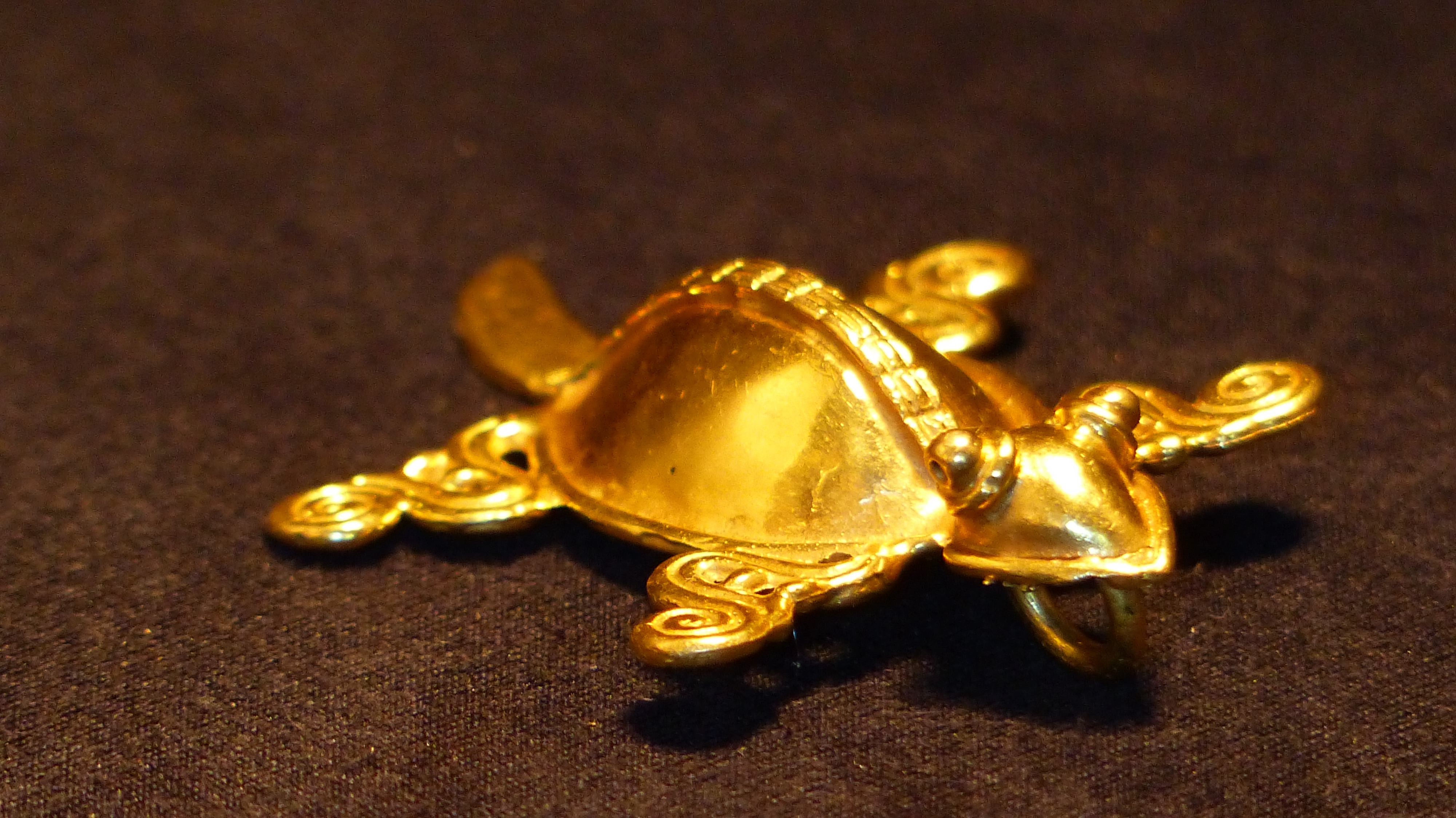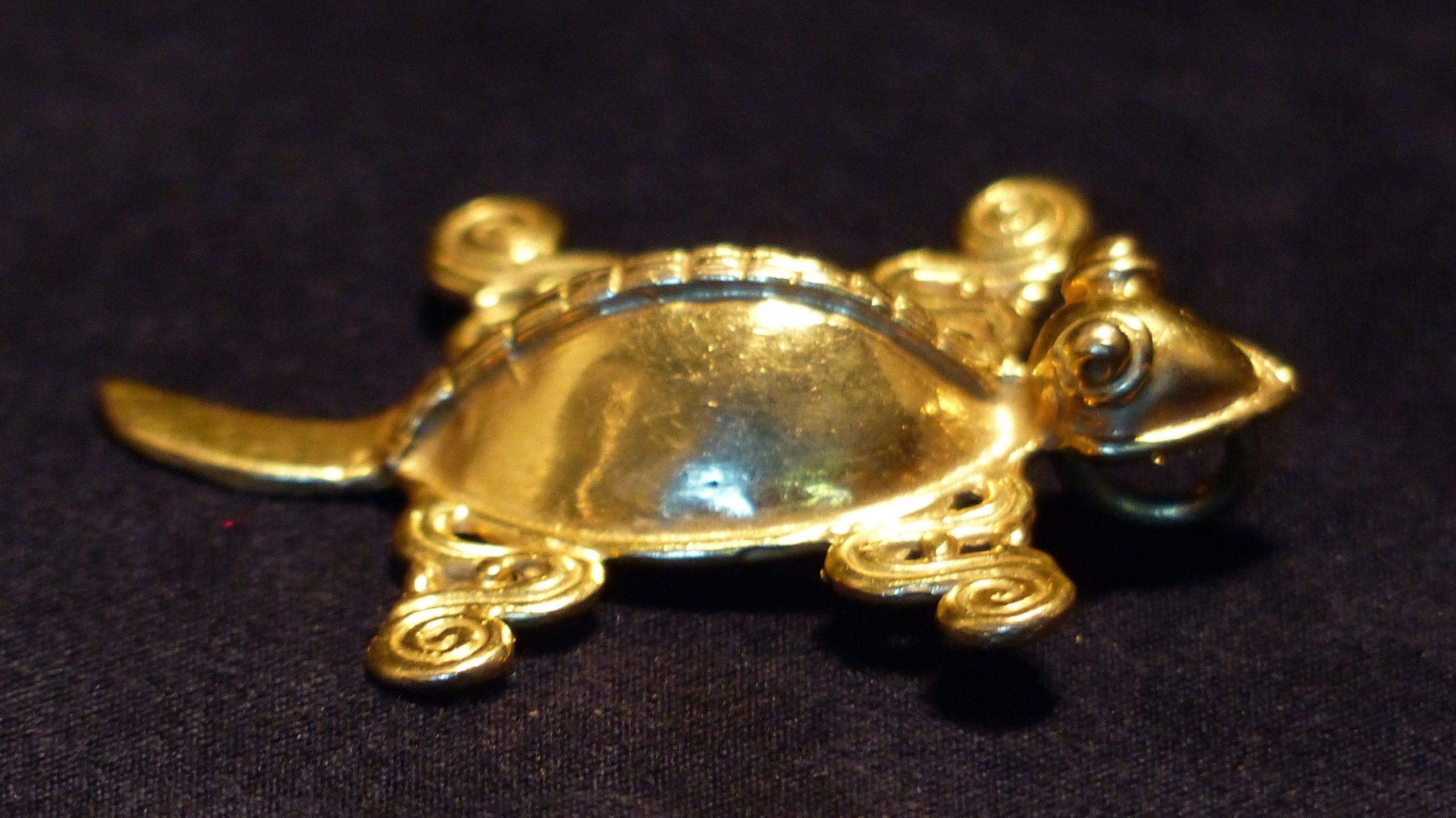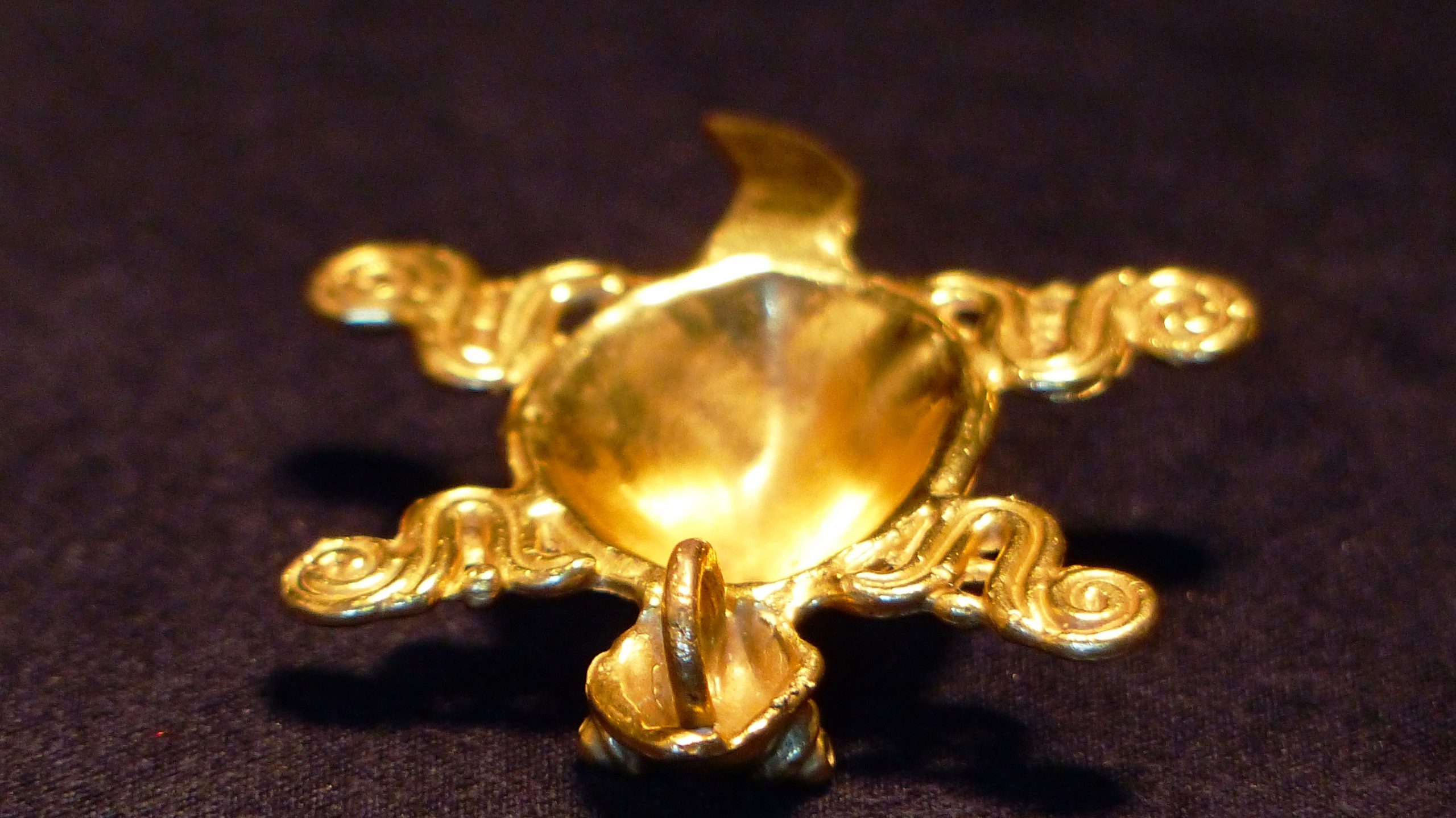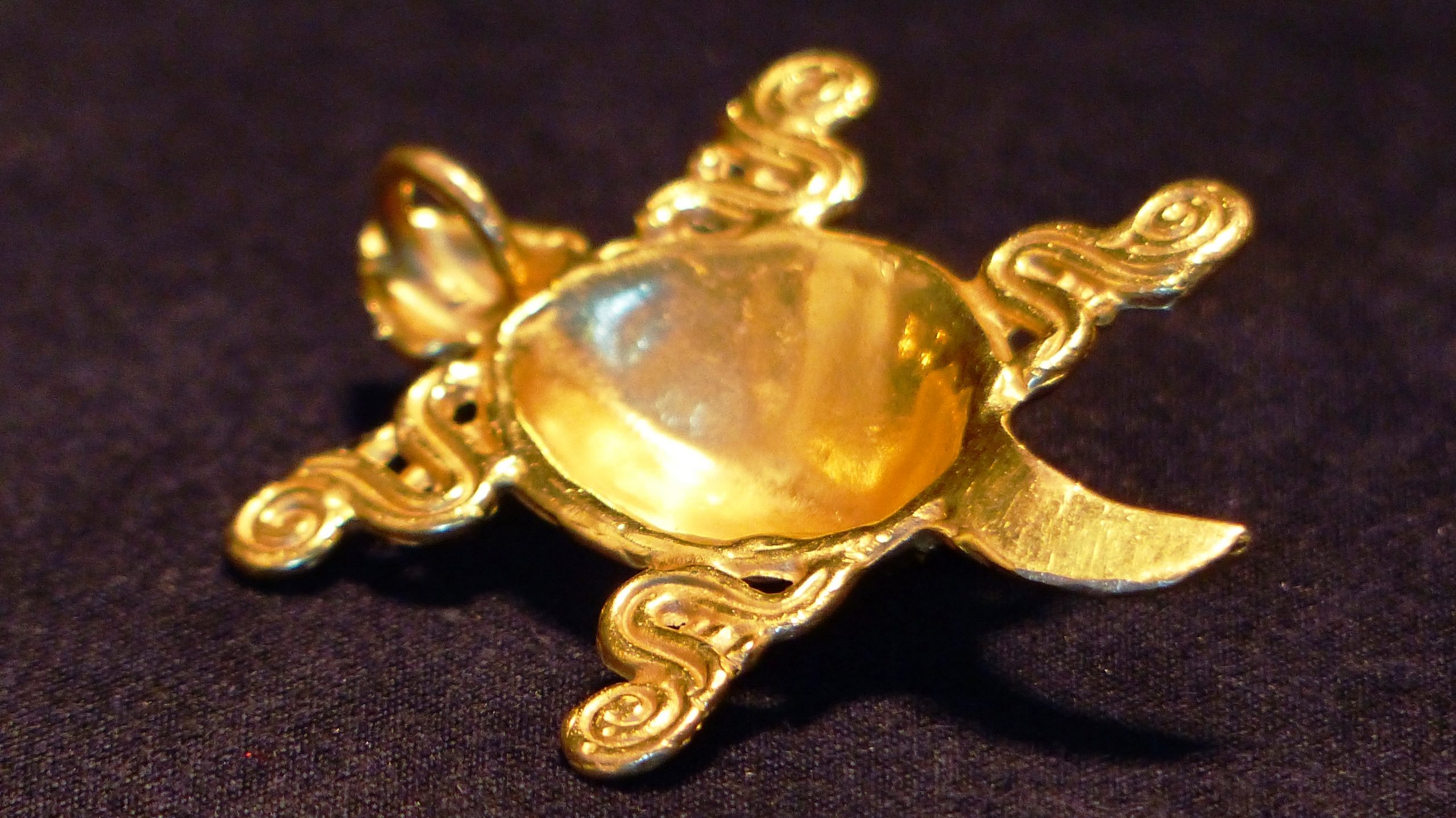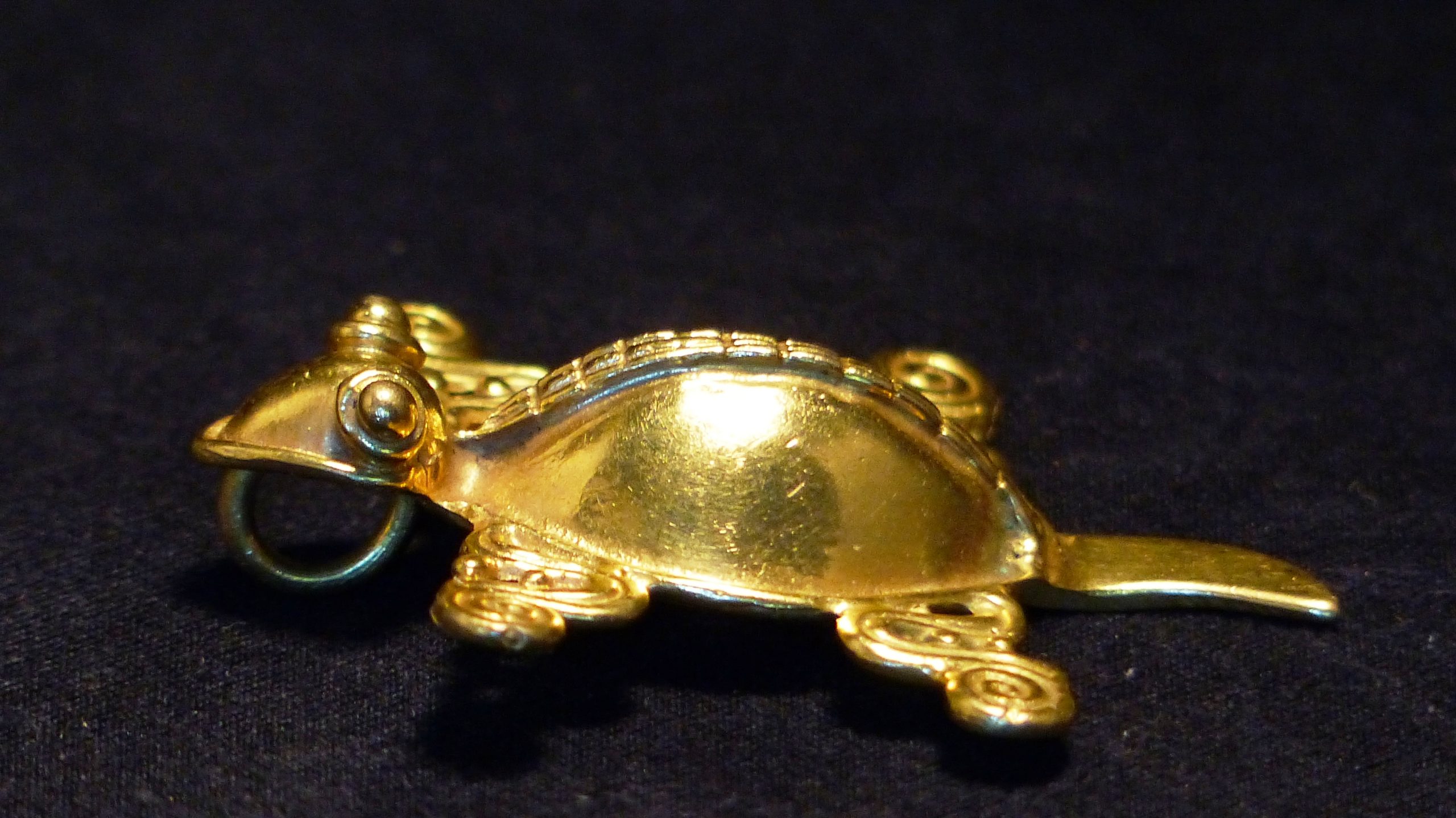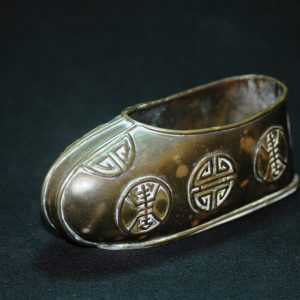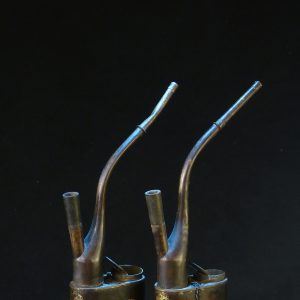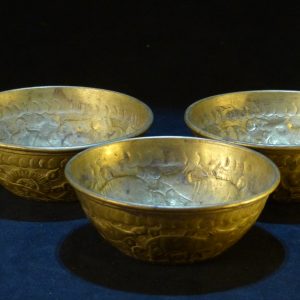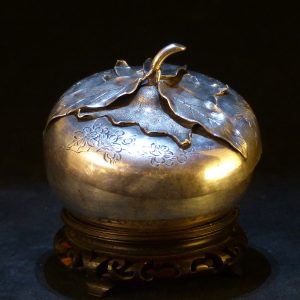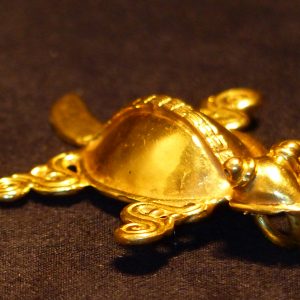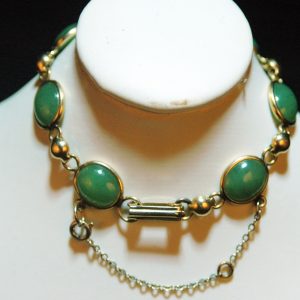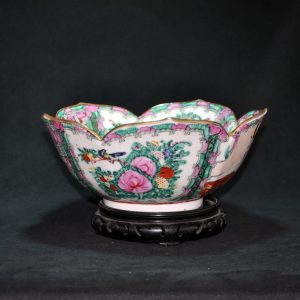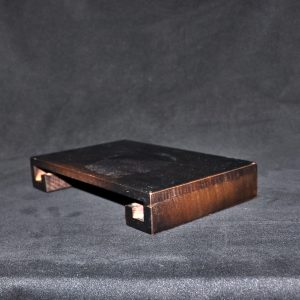Description
玛雅风格 铸龟纯金项链吊坠
参考:佳士得
November 10 | Live Auction 19339
Pre-Columbian Art & Taino Masterworks from the Fiore Arts Collection
Lot 43
PECTORAL
COCLÉ
THE JAMES AND MARILYNN ALSDORF COLLECTION
PECTORAL COCLÉ
ENV. 700-1520 AP. J.-C.
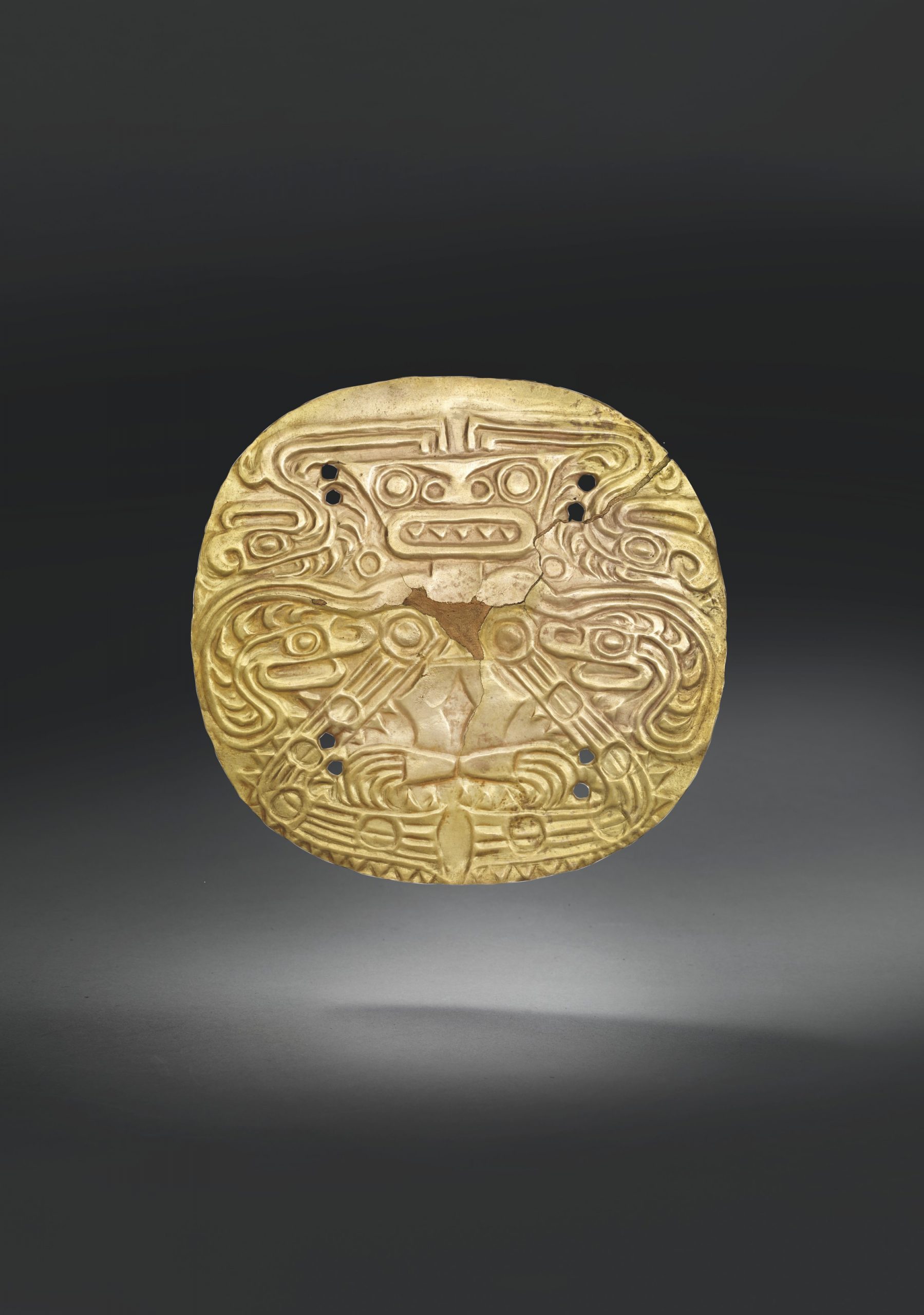
Estimate EUR 10,000 – EUR 20,000
PECTORAL COCLÉ
ENV. 700-1520 AP. J.-C.
PECTORAL
COCLÉ
ENV. 700-1520 AP. J.-C.
Diamètre : 12 cm. (4 ¾ in.)
Provenance
Collection Capitaine B.J. Linden, Balboa, acquis en 1963
Aaron Furman, Furman Gallery, New York
Collection James et Marilynn Alsdorf, Chicago, acquis auprès de ce dernier en avril 1973
COCLÉ GOLD PECTORAL
The circular plaque embossed with exuberant imagery with a standing fierce figure of a “crested alligator”, the complex personage with characteristic elongated arms extended with curled reptilian claws and talons and a toothy grin, surrounded by snouted, serpent heads, when the pectoral is turned upside down a stylized face is depicted; with eight holes for attachment.
The pervasive “crested alligator” imagery in Cocle art of the ancient isthmian region was associated with water, strength and fertility. The ruling elite probably wore such adornments in order to assume the might of these aggressive amphibians.
For a similar example, see Brooklyn Museum, inv. no. 33.448.12.
Lot Essay
Plaque circulaire en relief avec huit trous pour la fixation et décorée d’une iconographie abondamment développée qui représente un farouche « alligator à crête » montré debout sous la forme complexe d’un personnage aux bras caractéristiques allongés qui se prolongent avec des griffes incurvées et des pattes de reptile, avec un sourire carnassier et encadré de têtes de serpents à museaux, et qui montre un visage stylisé lorsqu’on retourne le pectoral.
La présence omniprésente d’un « alligator à crête » dans l’art Coclé de l’ancienne région de l’isthme était associée à l’eau, à la force et à la fertilité. L’élite dirigeante portait probablement de tels ornements pour s’accaparer la puissance de ces amphibiens agressifs.
Pour un modèle similaire, voir Brooklyn Museum, inv. n° 33.448.12.
参考:佳士得
November 10 | Live Auction 19339
Pre-Columbian Art & Taino Masterworks from the Fiore Arts Collection
Lot 42
GRAND PECTORAL
DARIEN
PROVENANT D’UNE COLLECTION OUTRE-ATLANTIQUE
GRAND PECTORAL DARIEN
ENV. 1-500 AP. J.-C.
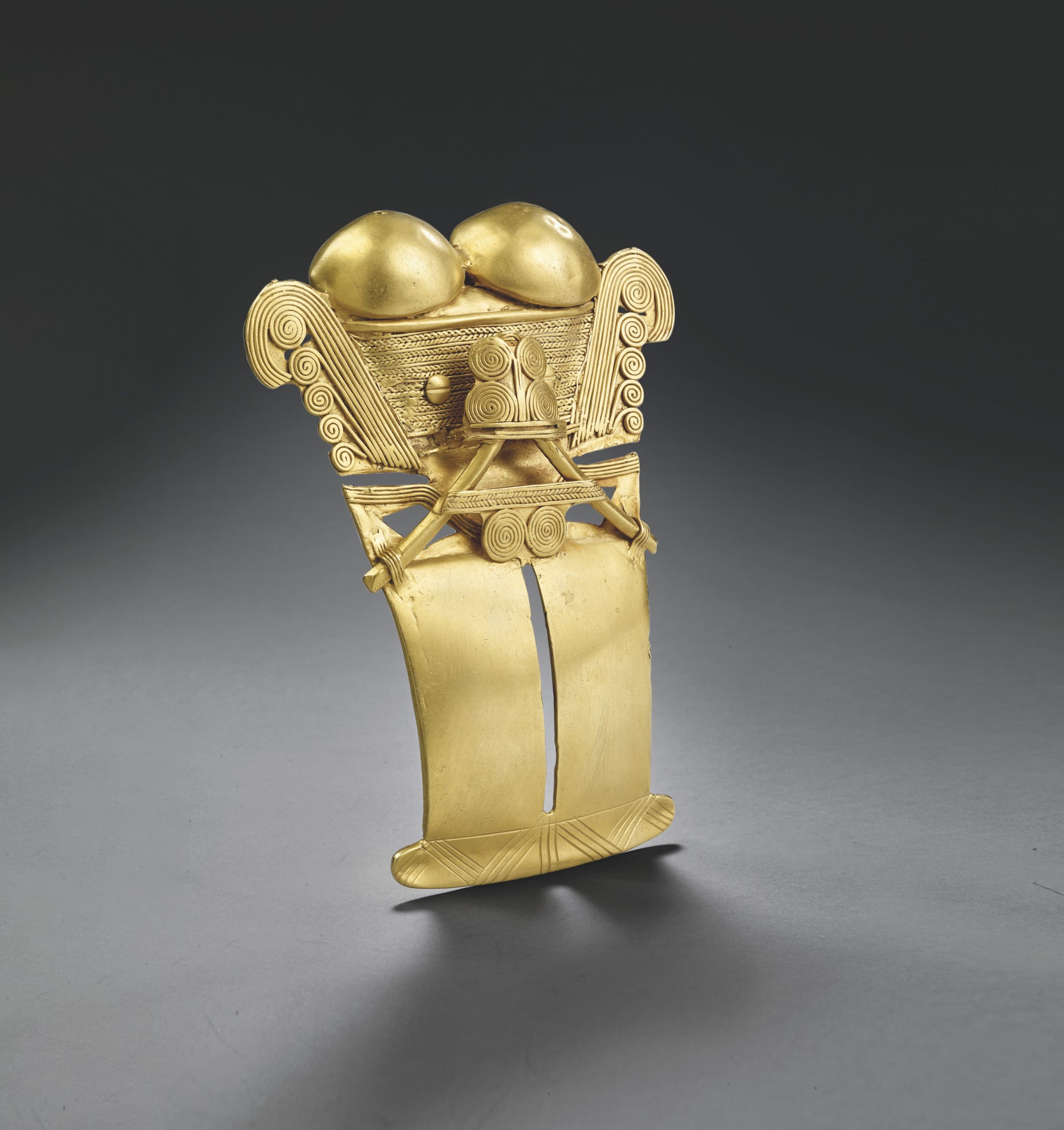
Estimate EUR 40,000 – EUR 60,000
GRAND PECTORAL DARIEN
ENV. 1-500 AP. J.-C.
Details
GRAND PECTORAL
DARIEN
ENV. 1-500 AP. J.-C.
Hauteur : 15.6 cm. (6 ½ in.)
Provenance
Collection privée américaine
Sotheby’s, New York, 23 novembre 1998, lot 35
Acquis par l’actuel propriétaire lors de cette vente
Post lot text
LARGE DARIEN GOLD PECTORAL
The imposing abstract figure possibly representing a shaman or cacique with long, schematic legs with stylized feet represented with chevron motifs, diminutive hands holding curved staffs to the upper jaw, wearing a highly stylized zoomorphic mask with upturned snout composed of spiral sprays, braid work for the facial plane and horizontal bisected eyes, the whole flanked by graduated spirals, further surmounted by twin semispherical headdress, considered an allusion to psychoactive mushroom caps.
These abstracted figures may represent caciques or shamans in the midst of hallucinogenic rituals in which visionary journeys connected the shaman chiefs to supernatural forces thus imbuing them with sacred and restorative power. In ancient Amerindian cultures, metals were not esteemed as a source of wealth but were charged with spiritual meaning and represented a rich symbolic language.
“Darién pendants depict ceremonial paraphernalia linked to the world of transformations”, Falchetti de Sáenz, A.M., “The Darién Gold Pendants of Ancient Colombia and the Isthmus” in Metropolitan Museum Journal, New York, 2008, vol. 43, p. 64.
For a comparable example, see the Metropolitan Museum of Art, inv. no. 1977.187.16.
Lot Essay
Pectoral orné d’un personnage abstrait imposant qui peut représenter un chaman ou un cacique avec de longues jambes stylisées aux pieds représentés par des motifs en chevrons, des petites mains tenant au niveau de la mâchoire supérieure des bâtons recourbés, portant un masque zoomorphe très stylisé avec un museau retroussé fait de spirales, avec des motifs en tresses pour représenter le visage et des yeux biseautés horizontaux, et surmonté d’une coiffe semi-sphérique double considérée comme une reférence à un chapeau fait de champignons psychotropes, le tout étant encadré de motifs en spirales échelonnées.
Ce type de personnage abstrait peut représenter un cacique ou un chaman lors d’un rituel hallucinatoire durant lequel il effectuait un voyage divinatoire qui le connectait à des forces surnaturelles et lui conférait ainsi un pouvoir sacré et guérisseur. Dans les anciennes cultures amérindiennes, les métaux n’étaient pas considérés comme une source de richesse, mais étaient emprunts d’une conception spirituelle et ils transcrivaient un riche langage symbolique.
« Les pendentifs Darién sont des accessoires de cérémonie liés à des rituels de transformation », Falchetti de Sáenz, A.M., « The Darién Gold Pendants of Ancient Colombia and the Isthmus » in Metropolitan Museum Journal, New York, 2008, vol. 43, p. 64.
Pour un modèle comparable, voir le Metropolitan Museum of Art, inv. n° 1977.187.16.
参考:佳士得
November 10 | Live Auction 19339
Pre-Columbian Art & Taino Masterworks from the Fiore Arts Collection
Lot 44
GRAND PENDENTIF
DIQUÍS, STYLE DE JALACA
PROPERTY FROM A PRINCELY COLLECTION
GRAND PENDENTIF DIQUÍS, STYLE DE JALACA
ENV. 800-1500 AP. J.-C.
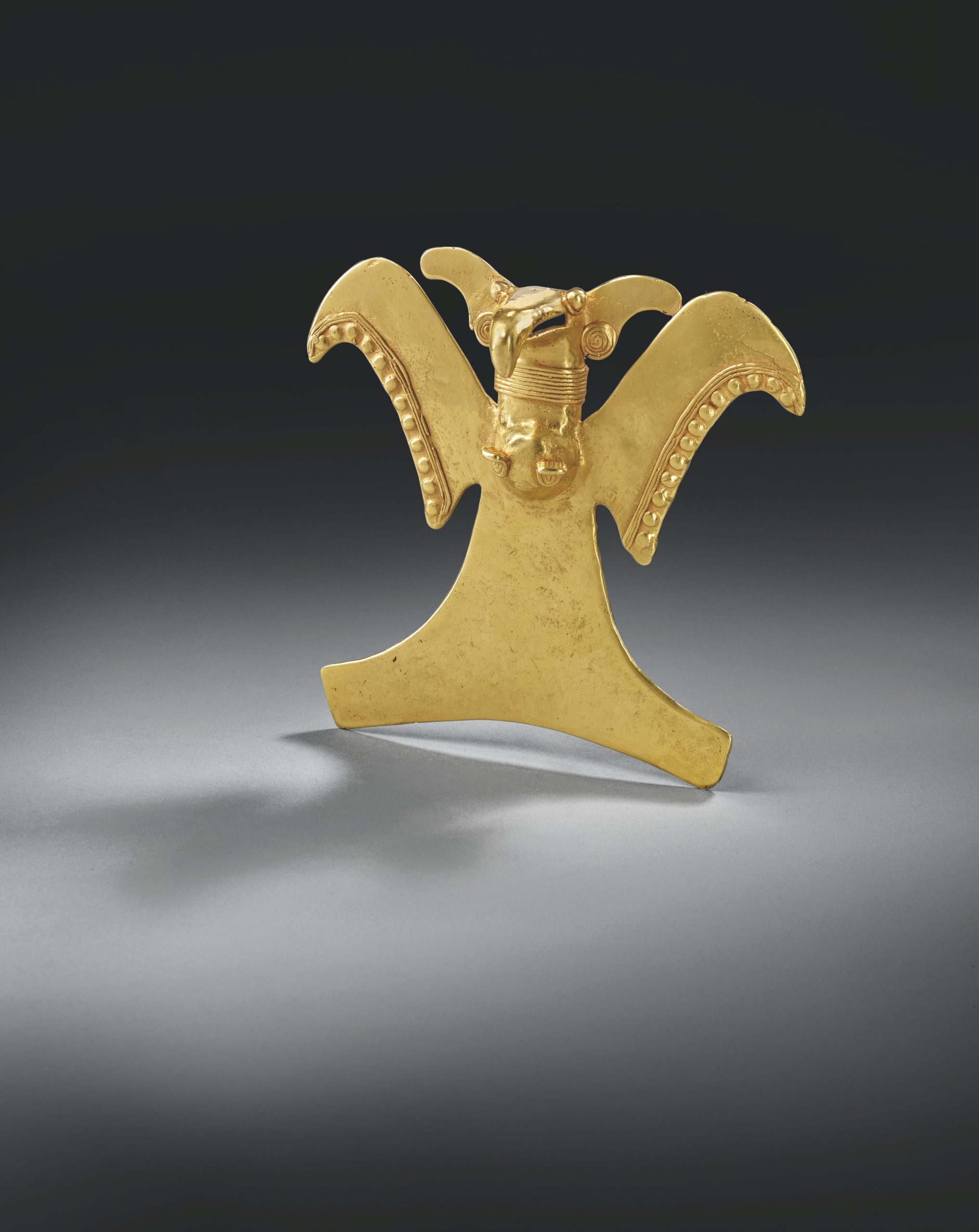
Estimate EUR 20,000 – EUR 30,000
GRAND PENDENTIF DIQUÍS, STYLE DE JALACA
ENV. 800-1500 AP. J.-C.
Details
GRAND PENDENTIF
DIQUÍS, STYLE DE JALACA
ENV. 800-1500 AP. J.-C.
Or
Hauteur : 12 cm. (4 ¾ in.)
Provenance
André Emmerich (1925-2007), André Emmerich Gallery, New York, début des années 1980, inv. n° CF1
Collection privée américaine, acquis auprès de ce dernier dans les années 1980
Sotheby’s, New York, 17 mai 2000, lot 64
Collection privée américaine, acquis lors de cette vente
Sotheby’s, New York, 13 mai 2011, lot 129
Collection privée, acquis lors de cette vente
Post lot text
LARGE DIQUÍS GOLD EAGLE PENDANT, JALACA STYLE
The harpy eagle (Harpia harpyja) notable for its striking presence with tall, deeply arched wings trimmed along the perimeter with beadwork and filigree for the plumage, with characteristic rounded chest and incised feet, the broad neck wrapped by multiple collars, pronounced open beak and spiral spray ear ornaments; a suspension loop at the back of the head.
The avian pendants of the Isthmian region were cast to underscore the large wingspan of these raptorial birds of the rainforest. The harpy eagle is considered the strongest among these birds of prey. When Columbus arrived in the early 16th century he encountered the indigenous inhabitants adorned with avian pendants suspended with cords around their necks.
Among the societies of Central America, gold ornaments were important symbols of prestige and power which expressed status in life as well as in death.
Brought to you by
Fatma Turkkan–Wille
Lot Essay
Grand pendentif avec une boucle de suspension à l’arrière et représentant une harpie féroce (Harpia harpyja) à la présence imposante avec de grandes ailes nettement aquées et bordées de motifs perlés et filigranés pour le plumage, avec une poitrine bombée caractéristique et des pieds incisés, au large cou encerclé par de multiples colliers, au bec ouvert prononcé et portant des ornements d’oreilles en spirales.
Les pendentifs aviformes moulés de la région de l’isthme ont été réalisés pour souligner l’importance des rapaces de la forêt tropicale, l’aigle harpie étant considéré comme le plus fort d’entre eux. Quand Christophe Colomb est arrivé au début du XVIe siècle, il a rencontré les populations indigènes ornées de tels pendentifs suspendus par des cordes autour de leur cou.
Les ornements en or étaient au sein des sociétés d’Amérique centrale d’importants symboles de prestige et de pouvoir qui indiquaient le statut aussi bien dans la vie que dans la mort.
参考:苏富比
AFRICAN, OCEANIC, AND PRE-COLUMBIAN ART
07 MAY 2016 | 5:00 PM EDT
NEW YORK
102
PROPERTY FROM A NEW YORK PRIVATE COLLECTION
Large Veraguas Gold Zoomorphic Pendant

ca. A.D. 800-1200
Estimate 20,000 — 30,000 USD
DETAILS & CATALOGUING
Large Veraguas Gold Zoomorphic Pendant
ca. A.D. 800-1200
densely cast as a composite creature of a crouching frog with wide paddle-shaped feet and the uplifted head of a feline with stylized alligator heads issuing from the mouth as fierce emanations, with perked ears, bulging eyes and teeth bared; suspension loops under the forelegs.
Length: 3 3/4 in (9.5 cm)
PROVENANCE
American private collector
Acquired by the present owner from the above in 1984
CATALOGUE NOTE
After 500 AD in Central America, gold becomes the favored medium over jade for displaying symbols of power. The massive lost-wax cast pendants of composite zoomorphic figures masterfully portray the prominent characteristics and mythical associations of the animals depicted. The forces of aquatic and terrestrial spirits are combined in balanced opposition on this large pendant.
Cf. Lothrop (1950:65) for a similar pendant style.
参考拍卖信息:PDF 目录



![[临渊阁]天地一家春](https://www.antiquekeeper.ca/wp-content/uploads/2023/03/cropped-Asian-Art-Wallpaper-Painting3-6-3.jpg)

